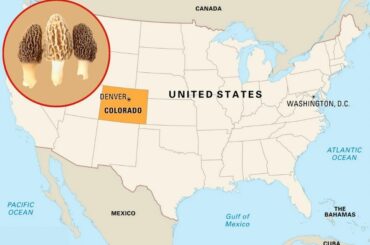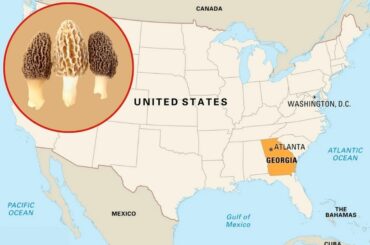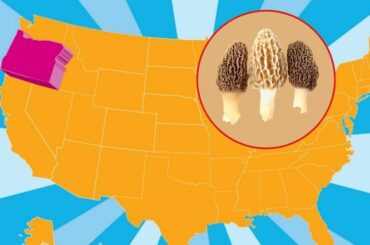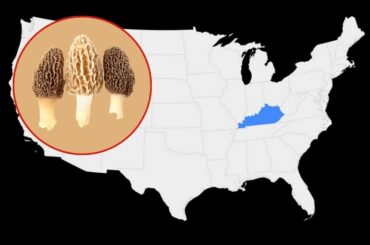Clathrus ruber belongs to the family Phallaceae. Due to its peculiar shape, Clathrus ruber is known as Coeur de Sorcière, which literally means Sorcerer’s Heart. They are commonly known as latticed stinkhorns, basket stinkhorns, or red cage. The fruiting body is red in color due to the presence of carotenoid pigments lycopene and beta-carotene. The inherent red color and the odor similar to the rotting meat seem to justify the common names given to Clathrus ruber.
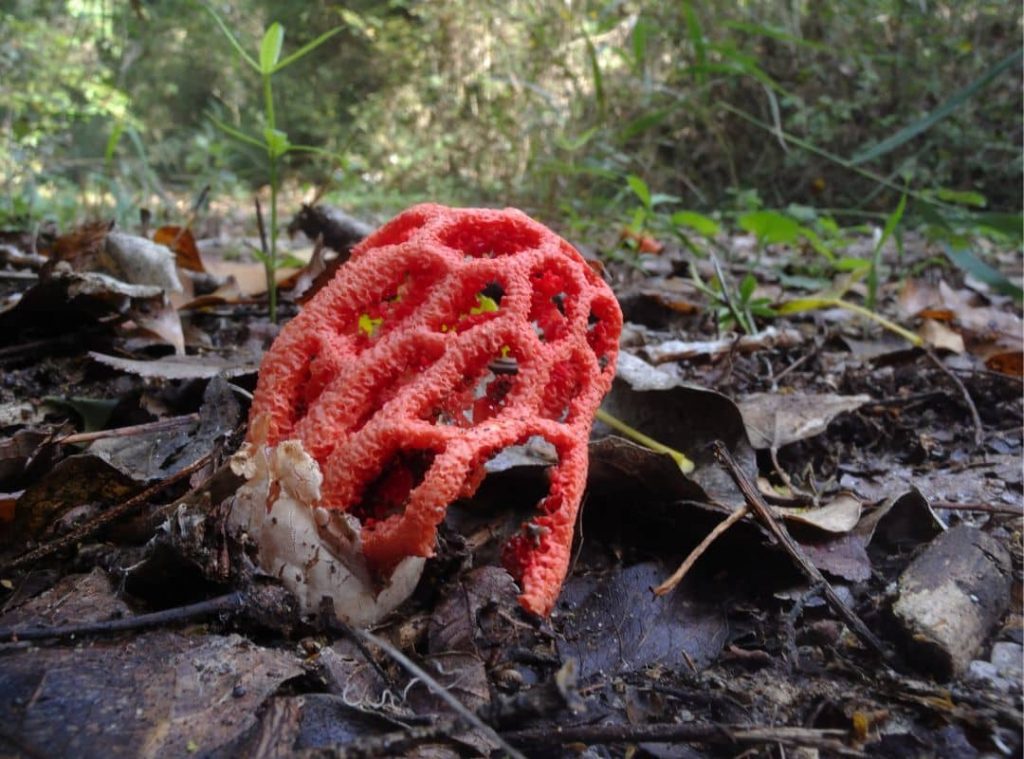
The red color is similar to meat and the foul smell attracts flies to the fruiting body of this mushroom. The flies help with the dispersal of the spores produced by the gleba, the slimy layer inside of the oval hollow sphere with interlaced branches or arms. The gleba also has higher levels of calcium which protect the fruiting body during development.
The egg of this mushroom has a gelatinous layer rich in potassium, calcium, manganese, and iron ions. Potassium helps the gelatinous layer keep the osmotic balance. High concentrations of the said elements support the rapid growth of the receptacle. This suggests that the gelatinous layer in the egg acts as a placenta which provides nutrients and an elemental reservoir to the receptacle as it grows. This variety of fungi is saprobic. Saprobic fungi feed on decaying woody plant material. It can be found in solitary or in groups in nature where decaying wood or leaves are present.
How can you identify the Clathrus ruber?
Contents
- 1 How can you identify the Clathrus ruber?
- 2 What size is Clathrus ruber?
- 3 When does Clathrus ruber grow?
- 4 Does Clathrus ruber contain any chemicals?
- 5 Is Clathrus ruber poisonous?
- 6 Clathrus ruber edible?
- 7 Where can I find Clathrus ruber?
- 8 The legal status of Clathrus ruber
- 9 Are there Clathrus ruber look-alikes?
- 10 How do I get rid of Clathrus Ruber?
- 11 Conclusion
Cap
The fruiting body of this mushroom is round and oval-shaped. The young stage of the fruiting body appears like a whitish egg. The egg connects with the ground by rhizomorphs. The young Clathrus rubber egg has a fragile leathery casing. Inside the casing, a compressed lattice of branches that contains the layer of olive-green slime called the gleba can be found. Gleba is where the mature mushroom produces the spores.
When it reaches maturity the fragile white casing of the egg ruptures and the oval-shaped lattice inside the egg starts to expand. These mesh of branches create semi-regular holes in the oval fruiting body. The branches or arms are thick, spongy, and hollow with a width of 1 cm. When the Clathrus ruber matures, the arms of the lower meshes vertically elongate. They can sometimes appear as supporting stems.
But the fruiting body attaches to the substrate with white rhizomorphs originating from the volva. The gleba starts to form a layer of slime inside the branches of the lattice and starts to produce dispersible spores. At this stage, the gleba starts to give out an odor similar to rotting meat. At the young stage, the egg reaches up to 3 to 5 cm in size. The mature fruiting body can reach 5 to 18 cm in height and 4 to10 cm in width.
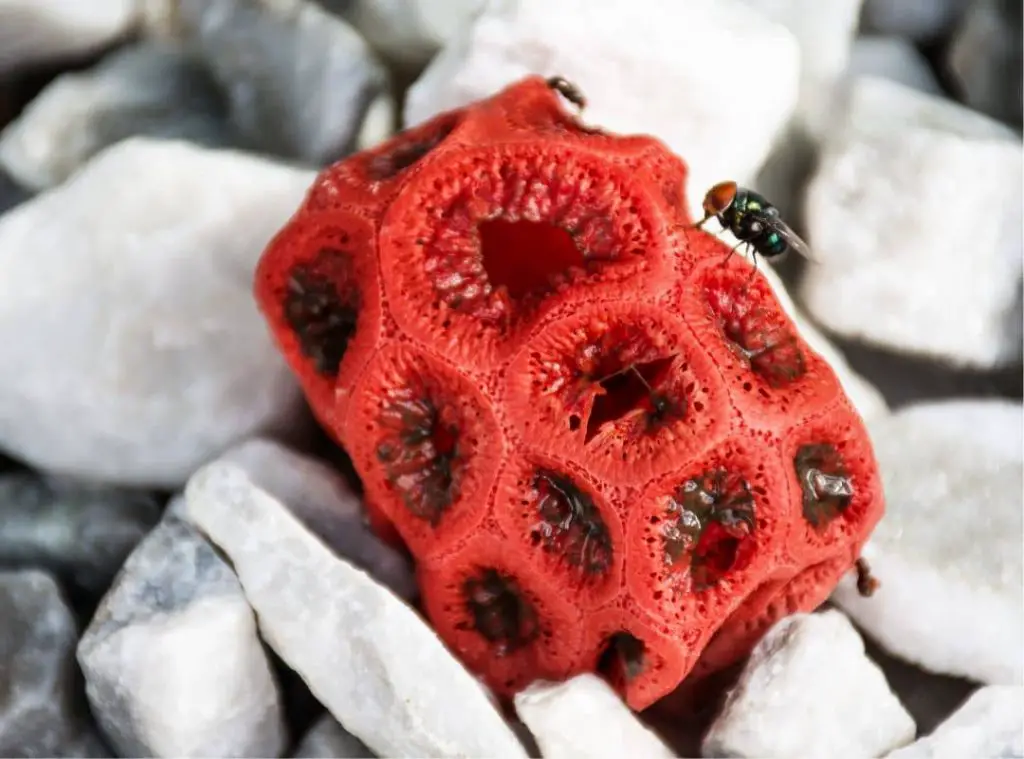
Gills
This mushroom does not have gills with a conventional appearance. The fruiting body of Clathrus ruber is a complex lattice. On the underside of that latice there is a gleba. It bears mushroom spores.
Stem
These mushrooms do not have a profound stem. The fruit body connects with the substrate by a volva. The volva is whitish to the pale brownish sac-like casing at the base of the fruiting body.
Spore print
The spore print of this mushroom is olive-brown in color. Spores of Clathrus ruber occur in a slime called gleba. Therefore, the spore print is not powdery like in most edible mushrooms.
Microscopic features
The spores of this mushroom are elongated, cylindrical, and smooth, and 4–6 by 1.5–2 µm in size. Clathrus ruber spores have a hilar scar which is a small indentation in the surface of the spore, where it was previously connected to the basidium. The basidia have six spores.
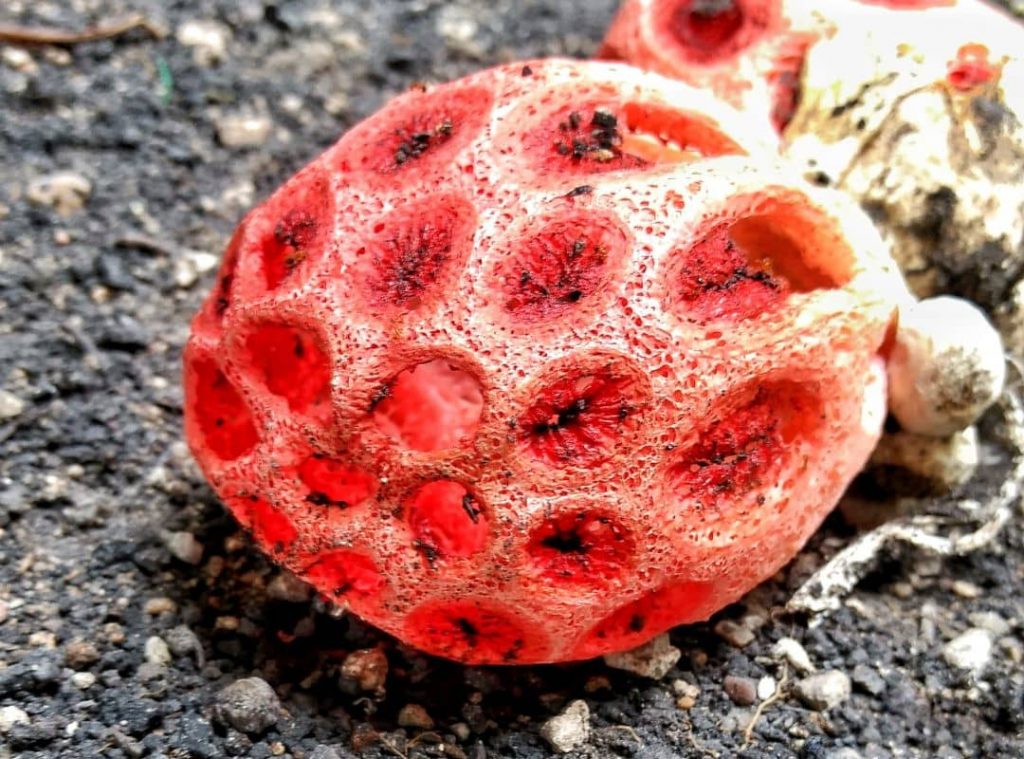
What size is Clathrus ruber?
The young fruiting body of this mushroom is called the egg and it can reach 3–5 cm across. A mature Fruiting Body is 5 to 18 cm in height and 4 to10 cm in width. Arms in the lattice of the fruiting body are hollow, spongy, and soft and are about 1 cm in thickness.
When does Clathrus ruber grow?
This mushroom can appear a few times a year. The season normally starts in June and ends in November.
Does Clathrus ruber contain any chemicals?
It is known to absorb and bioaccumulate manganese from the substrate. The bio-accumulated manganese is believed to be aiding in the enzymatic breakdown of the gleba, which then, in turn, produces foul-smelling substances such as; dimethyl sulfide, aldehydes, and amines.
Is Clathrus ruber poisonous?
It is generally listed as inedible and in some cases poisonous. But the egg stage of Clathrus ruber is considered edible and even considered a delicacy in some parts of the world. They are picked at the young stage, pickled, and sold in local markets as “devil’s eggs”. But there are reports to support the fact that consumption of this mushroom can cause serious gastric issues. It can also cause skin rashes and convulsions. In rare cases and with other complications, Clathrus ruber is reported to have caused death.
Some people even claim that the mushroom can have cancerous properties.
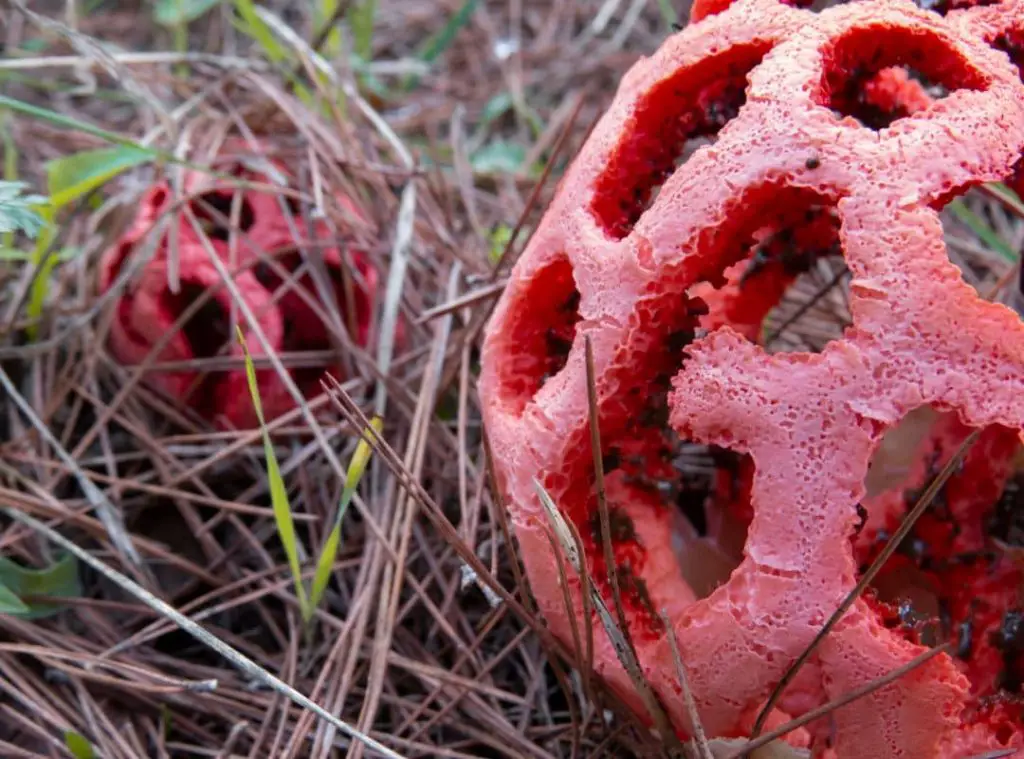
Clathrus ruber edible?
This mushroom is not widely accepted as an edible variety of mushrooms. At the mature stage where the Clathrus ruber develops the spore-bearing slime called gleba, the mushroom emits a strong foul smell similar to rotting flesh. This unbearable smell is one of the reasons why it is not a popular choice among mushroom eaters.
But in some countries and regions, the egg stage of Clathrus ruber is considered edible. It is even considered as a delicacy in some parts of Europe and Asia. They are picked at the young stage, pickled, and sold in local markets as “devil’s eggs”. At the egg stage, the gleba is not fully formed and does not produce spores. Therefore the gleba appears slightly darker and the smell is slightly bearable.
Where can I find Clathrus ruber?
The Clathrus ruber can be found solitary or in clusters on woody debris and leaves in forests and farmlands. Clathrus ruber originates from Italy but is found in southern and central continental Europe, western Turkey, North Africa, and western Asia. Clathrus ruber is rarely found in Central Europe and is considered endangered in some countries.
The legal status of Clathrus ruber
There is no information found on the legal status of Clathrus ruber. It is not recognized as a prohibited variety of mushrooms.
Are there Clathrus ruber look-alikes?
Clathrus ruber are look similar to Clathrus crispus, Clathrus chrysomycelinus and Clathrus columnatus. But you can still distinguish between species by using a few characteristics. Corrugated rims which are present in the branches of the fruiting body are absent in Clathrus crispus. Clathrus chrysomycelinus has a yellow receptacle. Clathrus columnatus has a fruiting body with two to five long vertical orange or red spongy columns joined at the apex instead of a complex lattice.
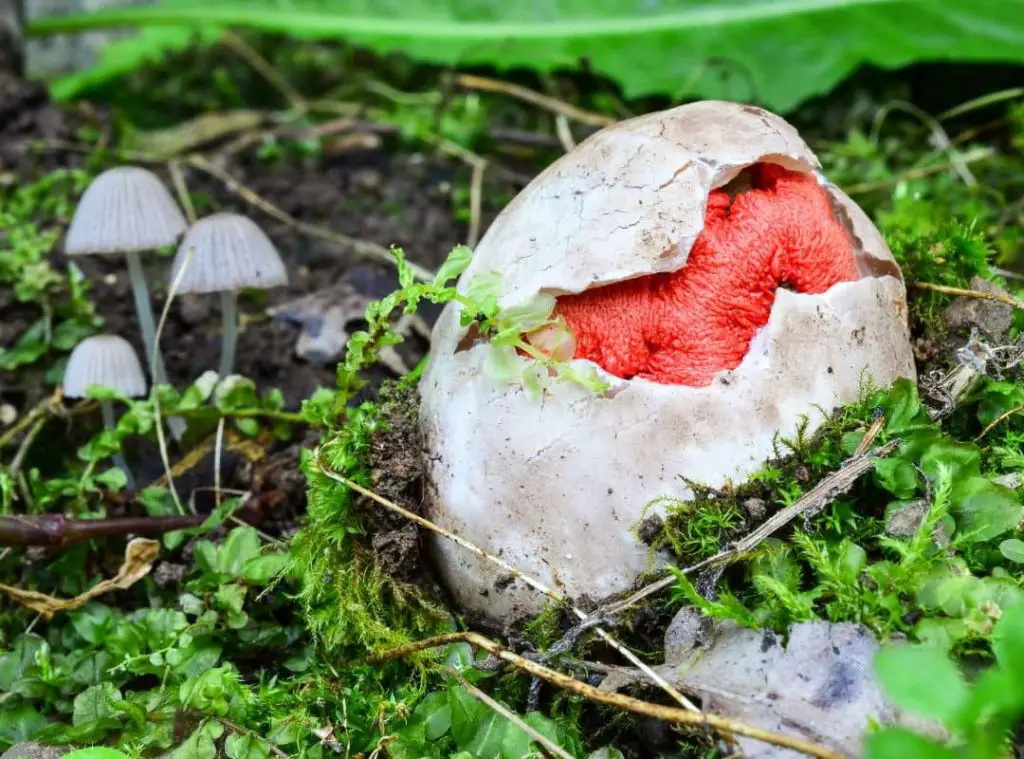
How do I get rid of Clathrus Ruber?
Clathrus ruber can be a nuisance in home gardens and can be nearly impossible to kill. The mature Clathrus ruber has a putrid rotting meat-like smell and the gleba attracts flies. Many gardeners prefer to get rid of Clathrus ruber even though it sticks only for a few days. This variety of fungus decomposes woody plant material. Therefore can mostly be seen growing on rotting organic matter.
One way to get rid of Clathrus ruber is to remove tree stumps, dead roots, and sawdust from your garden. You can also try to remove any egg-shaped young stage of this fungus as well. The egg stage can occur underground as well. When the fruiting bodies have formed, it is not easy to remove them completely. You can bury the fruiting bodies as a temporary measure. The Clathrus ruber can bloom a few times a year. Therefore it is important that you get rid of the younger stages as soon as you can and remove any food source they might feed on.
Conclusion
Clathrus ruber belongs to a group of fungi that are popularly known as stinkhorn fungi. As the name suggests, the fruiting body of Clathrus ruber emits a foul smell similar to rotting meat. The smell is mainly due to the compounds formed in the gleba which is the spore-bearing slimy substance inside the lattice of the fruiting body. The fruiting body of Clathrus ruber is red in color and formed by branches shaped like a mesh in a round or oval shape.
Clathrus ruber is not popularly known as an edible species. But the younger stage called the egg is considered a delicacy in some parts of the world. Although this variety of fungus is not considered poisonous, consumption of it may cause gastric issues.
Clathrus ruber blooms several times a year and can be a problem when found in home gardens due to its putrid smell. To get rid of the fungus, you need to get rid of the younger stages before they produce fruiting bodies. Getting rid of any piled up decaying woody plant matter is also important when trying to remove Clathrus ruber, as they thrive on decaying plant matter.
Read Next : Mushroom Casing Soil | Let’s Grow Mushroom |

